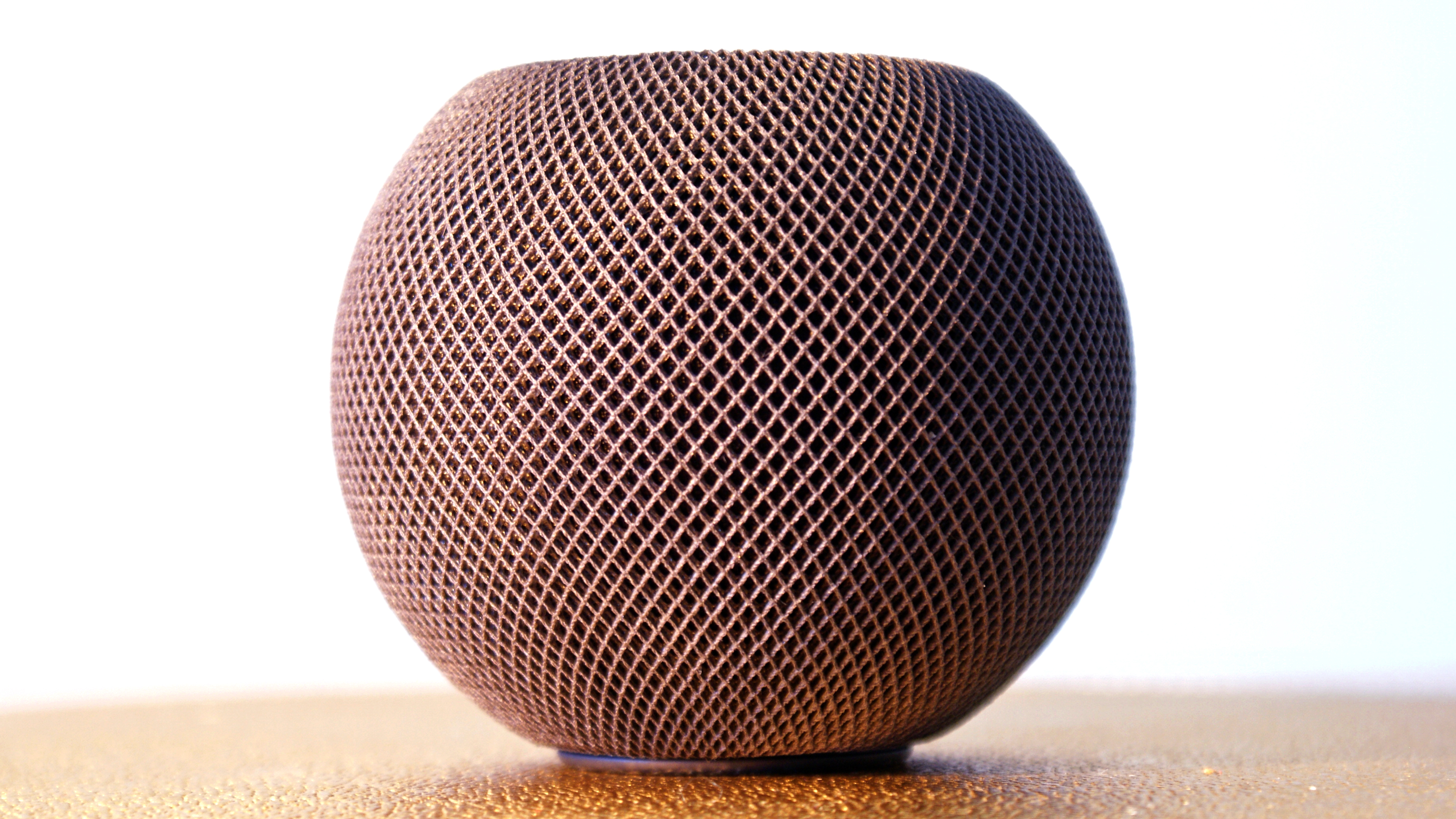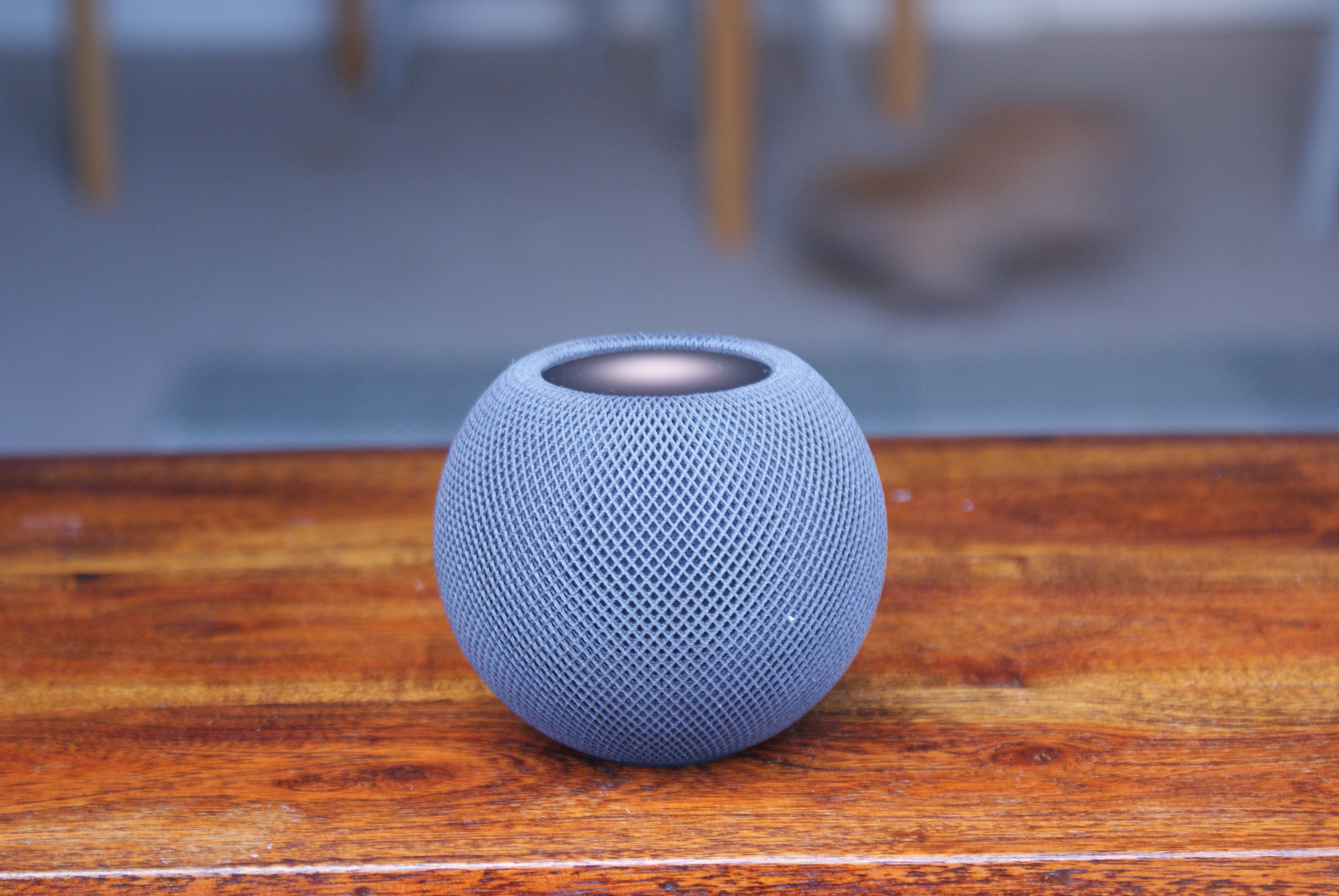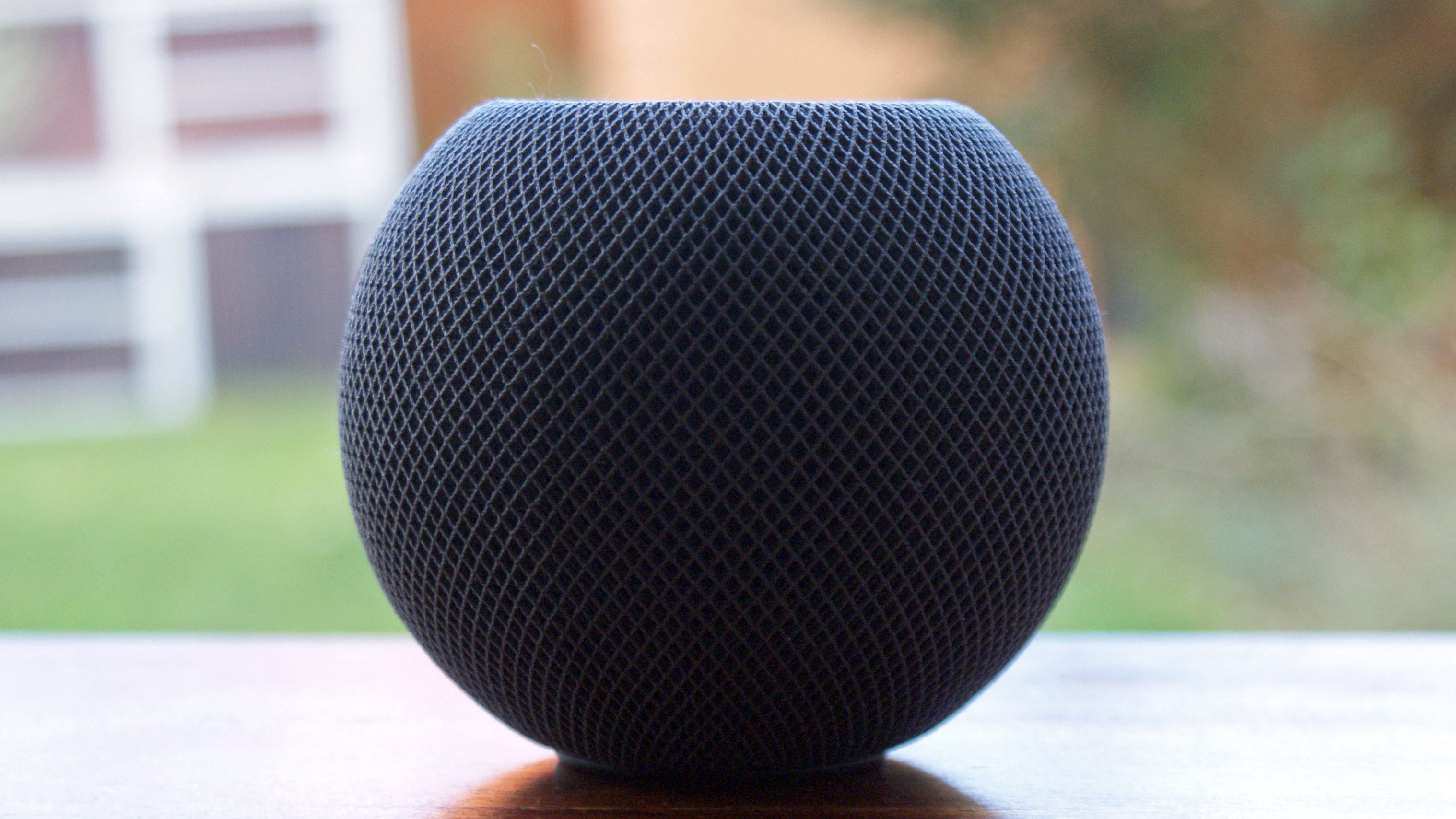Apple HomePod Mini
One-minute review
Apple is finally back in the smart speaker game, shrinking down its behemothic HomePod and bringing us the new, more compact HomePod Mini.
It's one of the cheapest devices Apple has ever put out: at $99 / £99 / AU$149, it's almost affordable for most, although it's going head to head with devices that can cost a fifth of that price at times, with the Amazon Echo Dot or Google Nest Mini being seen as its chief rivals.
However, Apple believes that a combination of Siri and excellent sound quality will win the day - and there are a number of impressive elements that come with this tiny speaker.
The first is the setup - you'll need an iPhone or iPad to use it, and you can simply hold it near the new HomePod mini and the connection is instant. All Wi-Fi passwords and accounts are synced, and if there are two speakers together they'll automatically pair (after checking that's OK).
In terms of getting up and running, it practically takes seconds – and it's a very inoffensive speaker too, with a small spherical design that takes up far less space than the original HomePod.

The latticed fabric shell blends nicely into the background, and the top glows with a pleasing light – although we do wish it would turn off at night for when you're listening to calming music when you sleep.
For us, the audio performance is the key reason to buy the HomePod mini. It's excellent for something so small, and it really feels like the right mix of price and sound quality together. The bass isn't too heavy, vocals aren't lost in the mix, and when paired with another HomePod mini, the stereo experience is really immersive.
However, if you don’t have an Apple Music account, you’re rather limited when it comes to music streaming. You can't ask the HomePod Mini to play anything through Spotify – that can only be enabled through AirPlay and requires using your phone rather than the simple method of asking Siri to play tunes with your voice. Essentially, there's a subscription required for using the HomePod Mini fully.
One of the biggest issues we encountered was when using the HomePod as a smart voice assistant. If your family is set up with multiple Apple devices, it works best, but controlling your smart home devices with your voice is still hit and miss.
We experienced multiple occasions when lights would turn on and off on command, only for a lamp or plug socket to randomly stay on, and a second command needing to be issued to get it to switch off. If your voice commands don’t work flawlessly every time, using a smart speaker instantly becomes a frustrating experience.
However, if you like using Siri and you've got an Apple Music subscription, buying a couple of HomePod Minis should be an easy choice. The sound quality is exceptional for the size, and the interconnection with Apple's smart home is largely strong, in spite of some issues.
HomePod mini price and release date

The HomePod mini is set to cost $99 / £99 / AU$149 when it launches on November 16 – and you can pre-order it now from Apple.
That's far cheaper than the original Apple HomePod, which cost $349 / £319 / AU$499 when it launched in 2018 – and the launch of the new HomePod mini means you can expect some fantastic Apple HomePod sales in the Black Friday deals or Cyber Monday sales.
That pricing puts the HomePod mini in direct competition with the new Amazon Echo (2020), which costs $99.99 / £89.99 / AU$149 – and it also shares a fairly similar spherical design.
It's not like Apple to price its products on the more affordable end of the spectrum – perhaps the company is anticipating that people will buy more than one unit (they do come with the ability to stereo pair, after all).
HomePod Mini setup

The Apple HomePod Mini setup is incredibly simple – easily the best we've seen for any smart speaker, especially if you don’t already have one in your home.
Once you’ve taken it out of the box and plugged it in, you'll be greeted with a small light that glows at the top of the speaker. Hold your iPhone near to the HomePod mini and you'll get a notification that asks if you'd like to connect – tapping this will activate the camera, which you can use to find the swirling light on top.
Once it’s been located, it's a few simple taps to transfer key information to the device – things like the Wi-Fi network are crucial, as that's how the HomePod Mini communicates with the world around it, and it's great to not have to dig out your Wi-Fi password again.
You'll also have your Apple ID synced across, as well as the choice of whether you want to enable it to just log information for you, or to allow personalized info for other people in your (pre-defined) household.
All of this is handled through the Home app on your iPhone, and this is also where you'll be asked to place it in a room (so you can say things like 'play music in the bedroom') as well as pairing with another speaker if you've happened to buy an even number of HomePod Minis – once again, these will be auto-detected by your iPhone and an option to pair is given straight to you.
HomePod Mini design

The HomePod Mini design is – and we hate to describe it in this way – so very Apple. It's understated, minimal, and attractive without being overbearing – it's kind of how most people would have drawn it if you'd said 'sketch a small speaker from Apple'.
Perhaps the only thing they'd get wrong is that it's spherical, which allows it to pump out 360-degree sound. This is a move that Amazon's made with the new Echo 2020, so it's clearly in fashion, but the sheer size (or lack thereof) of the HomePod Mini is what impresses, especially when you consider the sound quality it offers, which we'll get onto (and laud) in a moment.
The small sphere sits on a flat bottom, and while it's weighty enough to not get knocked around, it's got nowhere near the heft of the original HomePod. That lack of weight also means you won't need to worry about it marking the surface it sits on, as we saw with the larger HomePod.
The speaker is covered with a gray or white mesh, depending on your choice, and comes with a power lead attached that plugs into a USB-C charging block (which is thankfully included in the box, unlike the recent iPhone 12 range).
Actually, given that charging block retails for $19 / £19 / AU$29, it's actually something of a saving as you can use it to fast-charge an iPhone too – although you'll have to unplug the HomePod Mini, and it becomes useless if it can't respond to your voice.
It's a shame that Apple didn't make this portable with a small battery inside like the Sonos Move, but that would have increased the size and thus taken away from how impressively compact this little speaker is – it's easy to slot around the home, but equally looks fine placed on top of a bedroom cabinet or prominently displayed on a shelf.
HomePod audio performance

If there’s a single reason to buy the HomePod Mini, it’s the sound quality. We’re not used to saying this about many Apple products, but for the price you’re getting excellent value for money.
We noted above that the HomePod Mini design is similar to the new Amazon Echo 2020 in being spherical, but that speaker doesn’t have 360-degree sound, which Apple has packed into the new HomePod.
The sound is guided from the internal driver down to the base of the HomePod, where it fires outwards to create a more immersive sound.
Inside the HomePod mini is the new S5 chipset, which enables ‘computational audio’ according to Apple – in other words, the HomePod will analyze the song that’s playing and alter the response of the speaker accordingly.
The ability to tweak the audio output on the fly to improve the sound quality in real time, plus the use of a full-range driver and two passive radiators makes for a very impressive performance indeed – and the results speak for themselves.
We tested it with a variety of different musical genres, and while it’s not got the same oomph as the larger HomePod, it’s not that far off – and that device is far larger and more expensive.
The treble frequencies and vocals are really clear in every song, punching through bassy tracks with ease – everything we tested had a good balance, and even though the bass was often strong, it wasn’t overpowering in any genre.
The midtones were smooth, especially in pop songs, and cranking the sound levels didn’t add in distortion – if anything, the room-filling experience was enhanced at maximum volume.

We had one instance where, when using two HomePod Minis paired together, they fell slightly out of sync, but a restart fixed this. It used to happen more regularly on the larger HomePod a year or so ago, so we’re wary of it, but we only encountered it once.
Single instruments, such as the twanging guitar on Fleetwood Mac’s The Chain, or a single instrument in Mozart’s Jupiter, carried a real resonance – perhaps the only criticism we could have in our testing was that classical music could see instruments getting a little lost in the wider orchestral movements, but it was a minor - and arguably quite subjective - issue.
While the HomePod Mini won’t dazzle audiophiles with its quality, for the price and size it’s a very strong and capable speaker – Apple is banking on the fact that good audio quality is going to sell here, and for the ‘average’ music listener you’ll find little to fault, especially when two devices are paired together.
Music handoff is a new feature that you won't find on the bigger HomePod, as it uses the Ultra Wideband chip, the same inside the iPhone 11 and iPhone 12, to know when one of those phones is being pointed at it.
Get close, point your music-playing phone at the HomePod Mini, and a little rumble will tell you the music is now playing on the speaker. To 'steal it back', simply repeat the procedure and it'll come off the small HomePod to the phone again.
It's a really neat process, and one that will delight those that want to just pass music like it's magic (or just can't be bothered to fumble around, looking for the AirPlay icon to play your music on a speaker).
One thing we do wish Apple would offer as an alternative: the light on the top of the HomePod Mini is lit when playing music – that makes sense, but if you’re using it to go to sleep (playing rain sounds, or mimicking the ocean) it’s rather bright.
Apple sorely needs a ‘night mode’ for its speakers – as you want to be able to say ‘Hey Siri, goodnight’ and not have the HomePod scream back ‘OK, THE SCENE IS SET GOODNIGHT’, waking up half the household and lighting up the room if you want to keep listening to music.
Siri, HomeKit and Intercom

You might argue that the key reason to buy the new HomePod Mini isn’t the audio quality, although impressive for the price, but the ability to connect your world to a smart home with minimal fuss.
In that respect, the HomePod Mini is a useful tool. When it was announced alongside the iPhone 12, Apple went to great lengths to talk about how Siri is such an intuitive assistant, one that could easily help you on your phone, in your car, and when wandering around your home.
Wake up in the morning and ask it to play the news, and it’ll give you an update on what’s been happening from a local radio station. Ask it to alter your smart lights or control smart plugs (as long as they’re connected to your home network) and it’ll instantly switch them on and off as requested.
These are all things that the HomePod was capable of doing when we first reviewed it nearly three years ago, and in reality Siri hasn’t progressed massively as a smart assistant in that time.
There are some more useful features around, but it depends on how integrated you are with onboard Apple apps. You’ll need to be using the default calendar app to ask what appointments are coming up, and having Apple Maps set up to learn about traffic on your commute.
Things like asking ‘Hey Siri, what’s my update today?’ will give you weather, appointments and the latest news as a short podcast, but in truth we didn’t use this functionality all that much.
Many of these features are also things that you’d mostly do on your phone anyway, rather than have audio firing out your speaker and possibly waking up others in the household if you like your updates first thing in the morning.
Interacting with Siri is pleasant enough, with the cadence of its voice improved to be more natural-sounding in recent months – this is something Google and Amazon are trying to do with their assistants too, and it makes a big difference.

One thing that still needs improving is Apple’s smart home integration. Getting devices to pair with your smart setup isn’t too hard (although there are a few steps to take), but so often we were met with the equivalent of a virtual shrug when trying to turn our smart devices on and off.
The amount of times we heard ‘hmmm, that device doesn’t seem to be responding’ when asking it to turn off a set of lamps was annoying, and especially so when you asked again and found that it managed to turn it off after all.
Perhaps it’s a congested Wi-Fi network or just Siri timing out, but it made us lose faith in the system and just resort to turning it off manually at times – the HomePod mini needs to be faster to act when it works, and be more consistent in its functionality.
Another new feature with the HomePod Mini is the new Intercom feature, which allows you to tell Siri on your phone or HomePod to make announcements that are played on other HomePod speakers in your home, taking what you say and passing it around.
It’s a little cumbersome to use, as we found ourselves constantly rehearsing our lines to make sure it worked correctly. ‘Hey Siri, announce in the living room I’m sorry for noise, I just fell down the stairs’ was an awkward thing to say (for a number of reasons) but trying to remember how to phrase the announcement precisely took some getting used to.
This feature is going to be expanded in the months to come, where you’ll be able to make announcements on all devices connected to a household - be it iPhone or AirPods, you’ll be able to announce things to your family from afar and know that everyone heard what you had to say.
This could be an issue – if someone is having a conversation in a room and you just butt in with an intercom message, it might be a little intrusive. We understand why Apple built this feature in, but we rarely used it except for novelty value in our testing.
Buy it if…
Your family uses iPhones
The HomePod Mini is fine if you live alone, but can handle multiple users and is at its best in a wider household.
You have an Apple Music subscription
You need Apple Music to be able to command tracks with your voice - that's key to enjoying the HomePod Mini.
You’re good friends with Siri
Siri is either idiosyncratic or downright annoying at times - if you like the way it behaves, you'll enjoy the HomePod Mini a lot more.
Don’t buy it if…
You’re an Android user
This is a speaker for those embedded in the Apple ecosystem. You can hack around it if you're desperate for a HomePod, but it's far from ideal.
You don’t want to buy two
The HomePod Mini is so much more powerful with two together - the sound that the stereo quality brings really enhances the experience, so consider if you want a pair.
You have a lightly-sleeping household
Apple needs to make the HomePod more night-time friendly and not be so loud... or you need to find a perfect moment to ask it questions first thing in the morning.
Comments
Post a Comment